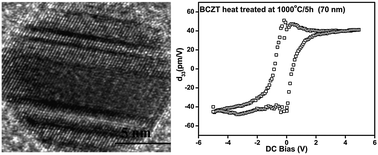Piezoelectric properties of individual nanocrystallites of Ba0.85Ca0.15Zr0.1Ti0.9O3 obtained by oxalate precursor route†
Abstract
Nanocrystalline Ba0.85Ca0.15Zr0.1Ti0.9O3 (BCZT) powder was synthesized via the complex oxalate precursor route at a relatively low temperature (800 °C/5 h). The phase formation temperature of BCZT at nanoscale was confirmed by thermogravimetric (TG), differential thermal analysis (DTA) followed by X-ray powder diffraction (XRD) studies. Fourier transform infrared (FTIR) spectroscopy was carried out to confirm the complete decomposition of oxalate precursor into BCZT phase. The XRD and profile fitting revealed the coexistence of cubic and tetragonal phases and was corroborated by Raman study. Transmission electron microscopy (TEM) carried out on 800 °C and 1000 °C/5 h heat treated BCZT powder revealed the crystallite size to be in the range of 20–50 nm and 40–200 nm respectively. The optical band gap for BCZT nanocrystalline powder was obtained using Kubelka Munk function and was found to be around 3.12 ± 0.02 eV and 3.03 ± 0.02 eV respectively for 800 °C (20–50 nm) and 1000 °C/5 h (40–200 nm) heat treated samples. The piezoelectric properties were studied for two different crystallite sizes (30 and 70 nm) using a piezoresponse force microscope (PFM). The d33 coefficients obtained for 30 nm and 70 nm sized crystallites were 4 pm V−1 and 47 pm V−1 respectively. These were superior to that of BaTiO3 nanocrystal (≈50 nm) and promising from a technological/industrial applications viewpoint.


 Please wait while we load your content...
Please wait while we load your content...